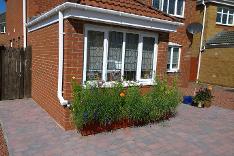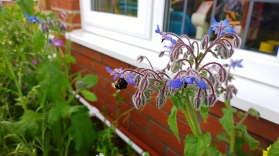Taking Action
What can we all do to reduce the risks and impacts of flooding?
The actions that YOU take on your property can contribute to making flooding better OR WORSE both on your property and outwith your property - YOUR ACTIONS CAN AND WILL IMPACT OTHERS.
We can all take action to to help minimise risks and impacts of flooding. The cumulative impact of many small interventions could result in a significant amount of runoff being attenuated (slowed down and temporarily stored) during a storm event. The next time it rains, grab your umbrella and take a walk to watch where the rain goes.
The following animation provides as useful overview on the challenges and how we can all play a part in reducing the risks and impacts - Let's Get Nibbling!
The following sections provide further information on specific actions that can be taken:-
Homeowners / Occupiers
Familiarise yourself with the national flood maps for Scotland - the maps show areas which are at risk of flooding from rivers, the sea and surface water, and are designed to help you understand how you could be affected by flooding. The maps are available online here - https://www.sepa.org.uk/environment/water/flooding/flood-maps/. This is particularly important if you are considering the purchase of a property.
If a property is at risk of experiencing a 1% (1 in 100yr) flooding event in any single year, the cumulative probability of that event occurring over the course of 20 years (roughly the length of a mortgage) rises to 18.21%. (Source - SEPA Technical Flood Risk Guidance for Stakeholders (p30) - https://www.sepa.org.uk/media/162602/ss-nfr-p-002-technical-flood-risk-guidance-for-stakeholders.pdf)
Prepare a flood plan - Floodline Scotland provides useful information about how to prepare for, react to and recover from flooding.
Floodwater is dangerous and contains pollutants - just 30cm of flowing water is enough to move a car, so never attempt to drive through floodwater, and definitely don't swim in it!
Consider installation of property flood resistance / resilience (PFR) measures - PFR (sometimes know as property flood protection (PLP) measures) can reduce the likelihood of flooding impacting your property, and reduce the amount of time to recover if flooding does happen. Further information on PFR measures are available online at a range of website, such as here, here, here, and here. CIRIA has also published a Code of Practice for PFR measures - available here - and produced an animation to support the Code of Practice - available here. The Scottish Goverment: Living with Flooding action plan recommends actions for a range of stakeholders to take to help promote property flood resilience in Scotland.
Maintain existing SuDS - many newer homes already have SuDS installed within the curtilage - usually in the form of permable paving driveway, sometimes also with storage below the surface. The property owner usually has responsibility to maintain these SuDS and ensure that they are operating effectively in terms of flood risk management and water quality.
Maintain your drainage and watercourses - to keep it clear of debris that may cause obstruction to flow. This includes culverted watercourses that may run underneath your land and for which you have responsibility as the 'riparian owner'.
Notify the council about blocked drains / road gullies - if you are aware of blocked drains / road gullies in your area, let the local council know asap so they can take action before the next time it rains.
Consider opportunities for retrofit surface water management SuDS and green infrastructure - to reduce the amount of and rate at which surface water from roofs and other hardstanding areas leaves your property, such as:-
- Install a waterbutt - waterbutts are an easy way to collect water from roofs when it rains, which can then be used to water your garden or for other uses. Ideally waterbutts should be drained down before the next storm event to provide storage volume for attenuation. This can either be done manually or through leaving the tap slightly open so that the waterbutt drains down slowly over time.
- Install a raingarden - create a raingarden by redirecting runoff from a downpipe into a specially planted area of your garden. This slows down the water, letting it soak into the ground and be taken up by the vegetation. An overflow back into the pipe drainage system may also be appropriate. Raingardens can become a home for plants, birds and insects. The 10,000 Raingardens for Scotland and Green Action Trust's websites provide more information on how this can be achieved.
- Install a raised planter - create a planter by redirecting runoff from a downpipe into a contained unit that has plants and a volume for storage. This slows down the water, letting it be taken up by the vegetation. An overflow back into the pipe drainage system may also be appropriate. Planters can become a home for plants, birds and insects. The 10,000 Raingardens for Scotland and Green Action Trust's websites provide more information on how this can be achieved.


- De-pave / Make your driveway and hardstanding areas more permeable - using porous materials will allow rain to soak into the ground. If you are considering adding new hardstanding areas (ie paving over your front garden), ensure you comply with The Town and Country Planning (General Permitted Development) (Scotland) Amendment Order 2011, which requires that any new hard surface between the property and the road must either be made of porous material or drain to a porous / permeable area, otherwise, you may be compelled to remove it! If you are considering building an extension, consider what impact the additional impermeable roof area may have on increasing flood risk both for yourself and communities downstream.
- Install a green roof / wall - green roofs / walls have plants and grasses growing on them which help soak up the water. As well as the stormwater management benefits, they can help with energy savings to the building that they are installed on through insulation, increase the life of the structure through protection and provide shelter for wildlife. Green roofs / walls can be installed on your home, shed, bin store, etc. The 10,000 Raingardens for Scotland and Green Action Trust's websites provide more information on how this can be achieved. Further information is also available via the Scottish Green Infrastructure Forum (SGIF) or the Green Roof Guide website.
When selling your house - make sure that details - location, purpose, maintenance responsibilities, mantenance regime / costs, etc - of any SuDS (either private or communal) are communicated to potential buyers to ensure awareness.
Further guidance is available on the following websites:-
Local Authorities and Other Public Bodies
Public bodies will do what they can to reduce the overall impacts of floods and ensure that, where possible, the risks are minimised.
Review the national flood maps for Scotland - to consider which areas and infrastructure is at risk of flooding from rivers, the sea and surface water. The maps are available online here - https://www.sepa.org.uk/environment/water/flooding/flood-maps/
Prepare a flood plan - Floodline Scotland provides useful information about how to prepare for, react to and recover from flooding.
Maintain drainage and watercourses - including culverted watercourses.
Maintain existing SuDS - in line with the recommended maintenance schedule to ensure they are operating effectively in terms of flood risk management and water quality.
Consider opportunities for retrofit surface water management SuDS and green infrastructure - to slow down / reduce surface water discharge. Further guidance is available on the following websites:-
Slow The Flow: At School & WWT SuDS for Schools
Raingardens in Schools leaflet and lesson resources
Raingardens in Built Developments leaflet, which provides an overview on the use of SuDS in a variety of settings.
Note - if you can remove all surface water discharge from your property (such as roofs, private car parks and private roads) to the public sewer, you may no longer have to pay the Property drainage charge element of your Drainage charge applied in relation to the ratable value of your property. You will still be liable for the Roads drainage element of the Drainage charge.
Businesses / Commercial / Industrial Landowners
Familiarise yourself the national flood maps for Scotland - the maps show areas which are at risk of flooding from rivers, the sea and surface water, and are designed to help you understand how you could be affected by flooding. The maps are available online here - https://www.sepa.org.uk/environment/water/flooding/flood-maps/
Prepare a flood plan - Floodline Scotland provides useful information about how to prepare for, react to and recover from flooding.
Maintain your drainage and watercourses - including culverted watercourses that may run underneath your land.
Maintain existing SuDS - (that have not been either adopted by the local authority or vested by Scottish Water) in line with the recommended maintenance schedule to ensure they are operating effectively in terms of flood risk management and water quality.
Consider opportunities for retrofit surface water management SuDS and green infrastructure - to slow down / reduce surface water discharge. Further guidance is available on the following websites:-
Raingardens in Built Developments leaflet, which provides an overview on the use of SuDS in a variety of settings.
Note - if you can remove all surface water discharge from your property (such as roofs, private car parks and private roads) to the public sewer, you may no longer have to pay the Property drainage charge element of your Drainage charge applied in relation to the ratable value of your property. You will still be liable for the Roads drainage element of the Drainage charge.
Designers
Ensure development proposals adequately consider surface water management / flooding - in line with national and local policy and guidance.
Encourage the use of SuDS / green infrastructure best practice and placemaking principles in development proposals - in line with the MGSDP Guiding Principles.
Ensure that new developments (of more than one dwelling) comply with the requirements of the Water Environment (Controlled Activities) (Scotland) Regulations 2011 regarding the provision of SuDS - ideally in line with the CIRIA SuDS Manual (C753) best practice and the current version of Sewers for Scotland (where appropriate). Note - the MGSDP supports the strong presumption against discharging surface water to the combined sewer network, as noted in Cl 2.7 of Sewers for Scotland
Raingardens in Built Developments leaflet, which provides an overview on the use of SuDS in a variety of settings.
Developers / Housebuilders
Ensure development proposals adequately consider surface water management / flooding - in line with national and local policy and guidance.
Encourage the use of SuDS / green infrastructure best practice and placemaking principles in development proposals - in line with the MGSDP Guiding Principles.
Ensure that new developments (of more than one dwelling) comply with the requirements of the Water Environment (Controlled Activities) (Scotland) Regulations 2011 regarding the provision of SuDS - ideally in line with the CIRIA SuDS Manual (C753) best practice and the current version of Sewers for Scotland (where appropriate). Note - the MGSDP supports the strong presumption against discharging surface water to the combined sewer network, as noted in Cl 2.7 of Sewers for Scotland
Ensure that property owners are aware of SuDS in the development - prior to making their purchase.
Ensure that property owners are aware of their responsibilities to properly maintain SuDS - that have not been either adopted by the local authority or vested by Scottish Water. This may be 'in-curtilage' SuDS or communal SuDS that are to be maintained by a factoring organisation.
Raingardens in Built Developments leaflet, which provides an overview on the use of SuDS in a variety of settings.

